
Spring Semester, 2002
Bridge & Abstract Factory
© 2002, All Rights Reserved, SDSU & Roger Whitney
San Diego State University -- This page last updated 25-Apr-02

|
CS 635 Advanced Object-Oriented Design & Programming Spring Semester, 2002 Bridge & Abstract Factory |
|
|---|---|---|
|
© 2002, All Rights Reserved, SDSU & Roger Whitney San Diego State University -- This page last updated 25-Apr-02 |
Bridge
Decouple the abstraction from its implementation
This allows the implementation to vary from its abstraction
The abstraction defines and implements the interface
All operations in the abstraction call method(s) its implementation object

What is Wrong with Using an Interface?
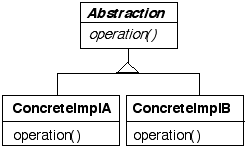
Make Abstraction a pure abstract class or Java interface
In client code:
Abstraction widget = new ConcreteImplA();
widget.operation();
This will separate the abstraction from the implementation
We can vary the implementation!
Applicability
Use the Bridge pattern when
Binding between abstraction & implementation
In the Bridge pattern:
Hide implementation from clients
Using just an interface the client can cheat!
Abstraction widget = new ConcreteImplA(); widget.operation(); ((ConcreteImplA) widget).concreteOperation();
In the Bridge pattern the client code can not access the implementation
Java AWT uses Bridge to prevent programmer from accessing platform specific implementations of interface widgets, etc.
Peer = implementation
public synchronized void setCursor(Cursor cursor) { this.cursor = cursor; ComponentPeer peer = this.peer; if (peer != null) { peer.setCursor(cursor); } }
Abstractions & Imps independently subclassable
Start with Widow interface and two implementations:
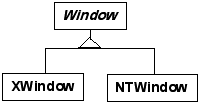
Now what do we do if we need some more types of windows: say IconWindow and DialogWindow?
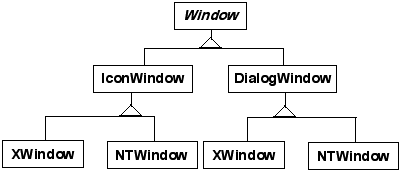
Or using multiple inheritance
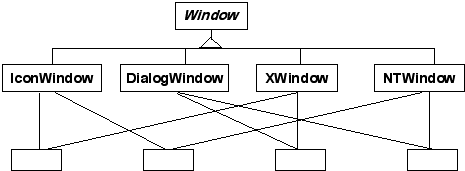
The Bridge pattern provides a cleaner solution
IconWindow and DialogWindow will add functionality to or modify existing functionality of Window
Methods in IconWindow and DialogWindow need to use the implementation methods to provide the new/modified functionality
This means that the WindowImp interface must provide the base functionality for window implementation
This does not mean that WindowImp interface must explicitly provide an iconifyWindow method
Share an implementation among multiple objects
Example use is creating smart pointers in C++

String contains a StringRep object
StringRep holds the text and reference count
String passes actual string operations to StringRep object
String handles pointer operations and deleting StringRep object when reference count reaches zero
|
String
a( “cat”);
String b( “dog”); String c( “mouse”); |
 |
|
a
= b;
|
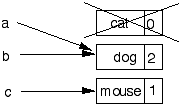 |
|
a
= c;
|
 |
C++ Implementation from Coplien class StringRep { friend String; private: char *text; int refCount; StringRep() { *(text = new char[1] = '\0'; } StringRep( const StringRep& s ) { ::strcpy( text = new char[::strlen(s.text) + 1, s.text); } StringRep( const char *s) { ::strcpy( text = new char[::strlen(s) + 1, s); } StringRep( char** const *r) { text = *r; *r = 0; refCount = 1;; } ~StringRep() { delete[] text; } int length() const { return ::strlen( text ); } void print() const { ::printf("%s\n", text ); } }
class String { friend StringRep public: String operator+(const String& add) const { return *imp + add; } StringRep* operator->() const { return imp; } String() { (imp = new StringRep()) -> refCount = 1; } String(const char* charStr) { (imp = new StringRep(charStr)) -> refCount = 1; } String operater=( const String& q) { (imp->refCount)--; if (imp->refCount <= 0 && imp != q.imp ) delete imp; imp = q.imp; (imp->refCount)++; return *this; } ~String() { (imp->refCount)--; if (imp->refCount <= 0 ) delete imp; } private: String(char** r) {imp = new StringRep(r);} StringRep *imp; };
Using Counter Pointer Classes
int main() { String a( “abcd”); String b( “efgh”); printf( “a is “); a->print(); printf( “b is “); b->print(); printf( “length of b is %d\n“, b-<length() ); printf( “ a + b “); (a+b)->print(); }
Abstract Factory
Task - Write a cross platform window toolkit
GUI interfaces to run on
Create
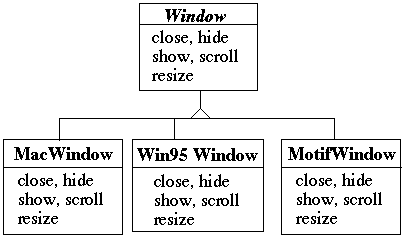
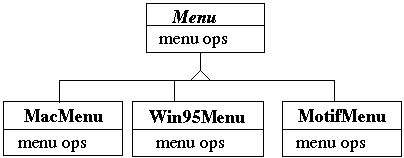
This allows the application to write to the widget interface
public void installDisneyMenu() { Menu disney = create a menu somehow disney.addItem( "Disney World" ); disney.addItem( "Donald Duck" ); disney.addItem( "Mickey Mouse" ); disney.addGrayBar( ); disney.addItem( "Minnie Mouse" ); disney.addItem( "Pluto" ); etc. }
How to create the widget so
Use Abstract Factory
abstract class WidgetFactory { public Window createWindow(); public Menu createMenu(); public Button createButton(); } class MacWidgetFactory extends WidgetFactory { public Window createWindow() { code to create a mac window } public Menu createMenu() { code to create a mac Menu } public Button createButton() { code to create a mac button } } class Win95WidgetFactory extends WidgetFactory { public Window createWindow() { code to create a Win95 window } public Menu createMenu() { code to create a Win95 Menu } public Button createButton() { code to create a Win95 button } }
Now to get code that works for all platforms we get:
public void installDisneyMenu(WidgetFactory myFactory) { Menu disney = myFactory.createMenu(); disney.addItem( "Disney World" ); disney.addItem( "Donald Duck" ); disney.addItem( "Mickey Mouse" ); disney.addGrayBar( ); disney.addItem( "Minnie Mouse" ); disney.addItem( "Pluto" ); etc. }
We just need to make sure that the application for each platform creates the proper factory
How Do Factories create Widgets?
Method 1) My Factory Method
abstract class WidgetFactory { public Window createWindow(); public Menu createMenu(); public Button createButton(); } class MacWidgetFactory extends WidgetFactory { public Window createWindow() { return new MacWidow() } public Menu createMenu() { return new MacMenu() } public Button createButton() { return new MacButton() } }
How Do Factories create Widgets? Method 2) Their Factory Method
abstract class WidgetFactory { private Window windowFactory; private Menu menuFactory; private Button buttonFactory; public Window createWindow() { return windowFactory.createWindow() } public Menu createMenu(); { return menuFactory.createMenu() } public Button createButton() { return buttonFactory.createMenu() } } class MacWidgetFactory extends WidgetFactory { public MacWidgetFactory() { windowFactory = new MacWindow(); menuFactory = new MacMenu(); buttonFactory = new MacButton(); } } class MacWindow extends Window { public Window createWindow() { blah } etc.
Method 2) Their Factory Method
When does this make Sense?
There might be more than one way to create a widget
abstract class WidgetFactory { private Window windowFactory; private Menu menuFactory; private Button buttonFactory; public Window createWindow() { return windowFactory.createWindow() } public Window createWindow( Rectangle size) { return windowFactory.createWindow( size ) } public Window createWindow( Rectangle size, String title) { return windowFactory.createWindow( size, title) } public Window createFancyWindow() { return windowFactory.createFancyWindow() } public Window createPlainWindow() { return windowFactory.createPlainWindow() }
Using factory method allows abstract class to do all the different ways to create a window.
Subclasses just provide the objects windowFactory, menuFactory, buttonFactory, etc.
How Do Factories create Widgets? Method 2.5) Subclass returns Class
abstract class WidgetFactory { public Window createWindow() { return windowClass().newInstance() } public Menu createMenu(); { return menuClass().newInstance() } public Button createButton() { return buttoneClass().newInstance() } public Class windowClass(); public Class menuClass(); public Class buttonClass(); } class MacWidgetFactory extends WidgetFactory { public Class windowClass() { return MacWindow.class; } public Class menuClass() { return MacMenu.class; } public Class buttonClass() { return MacButton.class; } }Smalltalk practice
Parent class normally does more complex stuff
How Do Factories create Widgets? Method 3) Prototype
class WidgetFactory { private Window windowPrototype; private Menu menuPrototype; private Button buttonPrototype; public WidgetFactory( Window windowPrototype, Menu menuPrototype, Button buttonPrototype) { this.windowPrototype = windowPrototype; this.menuPrototype = menuPrototype; this.buttonPrototype = buttonPrototype; } public Window createWindow() { return windowFactory.createWindow() } public Window createWindow( Rectangle size) { return windowFactory.createWindow( size ) } public Window createWindow( Rectangle size, String title) { return windowFactory.createWindow( size, title) } public Window createFancyWindow() { return windowFactory.createFancyWindow() } etc.
There is no need for subclasses of WidgetFactory.
Applicability
Use when
Consequences
Problem: Cheating Application Code
public void installDisneyMenu(WidgetFactory myFactory) { // We ship next week, I can't get the stupid generic Menu // to do the fancy Mac menu stuff // Windows version won't ship for 6 months // Will fix this later MacMenu disney = (MacMenu) myFactory.createMenu(); disney.addItem( "Disney World" ); disney.addItem( "Donald Duck" ); disney.addItem( "Mickey Mouse" ); disney.addMacGrayBar( ); disney.addItem( "Minnie Mouse" ); disney.addItem( "Pluto" ); etc. }
How to avoid this problem?
Copyright ©, All rights reserved.
2002 SDSU & Roger Whitney, 5500 Campanile Drive, San Diego, CA 92182-7700 USA.
OpenContent license defines the copyright on this document.
Previous visitors since 25-Apr-02 Next